ATTRIBUTE-BASED CONFIGURATORS VS. PRODUCT-BASED CONFIGURATORS
Choosing the Best Solution for your Business
Download the PDF
The State of the Configuration Market
Across industries, businesses are looking to create the best and most flexible customer experiences,
but have often been limited by the way their internal sales and commerce systems operate.
Products like CPQ have evolved over time to help translate the way that products are managed in the back office to a more sales- friendly and customer-friendly, solution-oriented experience. A key component of a CPQ or commerce system’s effectiveness in achieving this is in the way the “C” is architected.
Whether the system is built based on “product based” config or “attribute-based” configuration specs can make a distinct difference in experience. It’s not just a matter of managing products internally, but getting the flexibility to sell them through any channel, to any buyer.
Businesses want to follow the path that will provide them the most flexibility while keeping administrative costs and requirements as low as possible. Buyers, conversely, are establishing not just preferences, but expectations for quick, customizable, sales-repfree experiences. The million-dollar question is which configuration method can balance both goals in a future-proof way: product-based, or attribute-based?
Product-Based vs. Attribute-Based Configuration
There are two main methods of configuration that can be deployed, product-based configuration and attribute-based configuration.
Though product-based configuration has a historic precedent, attribute based has exploded on the scene in direct response to buyer wants, making a name for itself as the best, fastest, and cheapest configuration option around. In order to properly understand the relevance and importance of both, particularly in how they relate to each other, a bit of history is required. Here, Logik.io Co-Founder and Vice President of Product Management Fazal Gupta, sheds some light
Quick History:
Looking back to the days of the Industrial Revolution, Fazal explains how buyers were faced with a burgeoning market that emphasized the creation of tangible, mass-produced goods to shill. There was little consideration of exchanging cash for services at that point, with buyer capital being directed toward these physical items, and the sense of pride in ownership that came along with them. As the Industrial Revolution advanced, and eventually started giving way to the Information Era, buyers began to see a shift away from just physical goods, and a preference for solution-based services.
Quality of life became the hot topic, and businesses soon realized that buyers were interested in what businesses could do for them, not what they could walk away owning from them.
Service-based businesses began absorbing products and converting them into subscription accounts, short- term rentals, try-and-return options, and so forth. Businesses still focusing on physical sales saw a buyer divestment from catalog items, and a preference for personalized, adaptive items. Here is where attribute-based configuration was able to latch onto, and begin satisfying, an unmet need for both buyers and sellers.
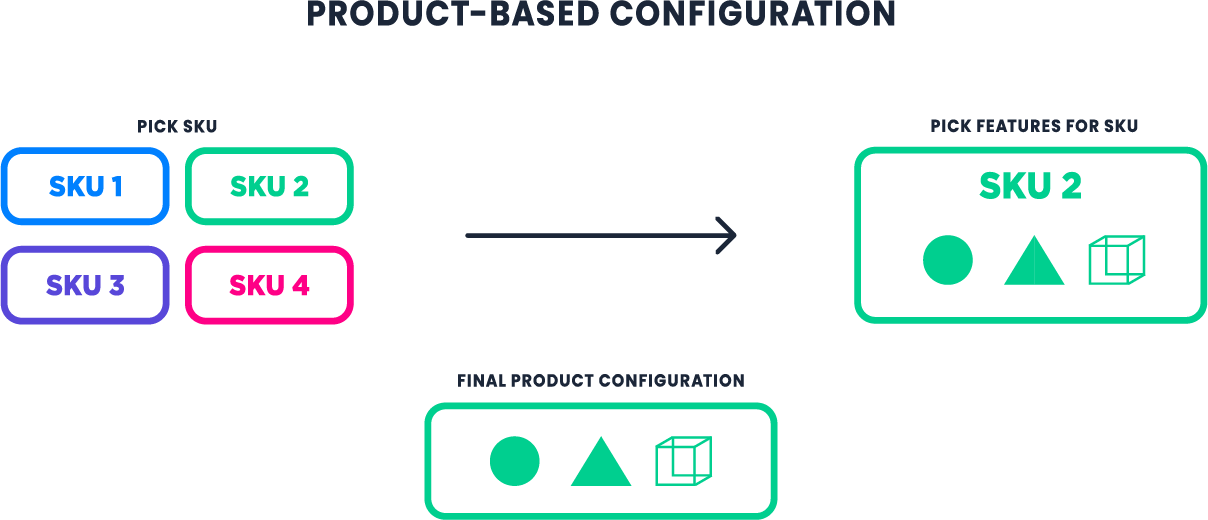
Product-Based Configuration
The precedent in the market for configuration architecture,
product-based configuration has been an integral component in the evolution of eCommerce and CPQ over the years. In direct sales settings, sales reps can utilize configurators with product-based configuration to find and select items and SKUs in an existing product catalog,
and suggest bundles or up-sells that could relate to the buyer’s cart. Because it was the leading configuration method for so long, many businesses specifically structured their sales protocol around its capacities. Outside of direct settings, though, it leaves much to be desired.
One undeniable point about product-based configuration is that it assumes the buyer has an existing, solid knowledge base about the business and product at hand. Historically, B2B sales settings have operated under these assumptions and left a high amount of personal responsibility in the lap of the buyer. As modern buyer personas shift toward demographics more familiar with B2C and rep-less sales settings, such expectations become less and less realistic.
As such, buyers are looking more toward guided selling experiences, in which the system leverages product rules and internal logic to make suggestions for the buyer.
Product-based configuration also begins to stall out when looking at scalability. Gupta warns that this setup is too blunt a tool to properly be used in conjunction with growing product complexity. As shown in the case study above, the success of such configuration hinges upon the existence and presentation of any and all possible item configurations, no matter how complex or niche they may be. Regardless of if there has ever been a noted consumer demand for a particular configuration, it must exist as an option.
More so, a single added or amended variable triggers an update that must be made to every single line item to which the variable applies. Looking at the labor requirements and physical time necessitated to complete such updates, along with the very real possibility of manual error or oversight when making them, highlights the instability of the legacy configurator
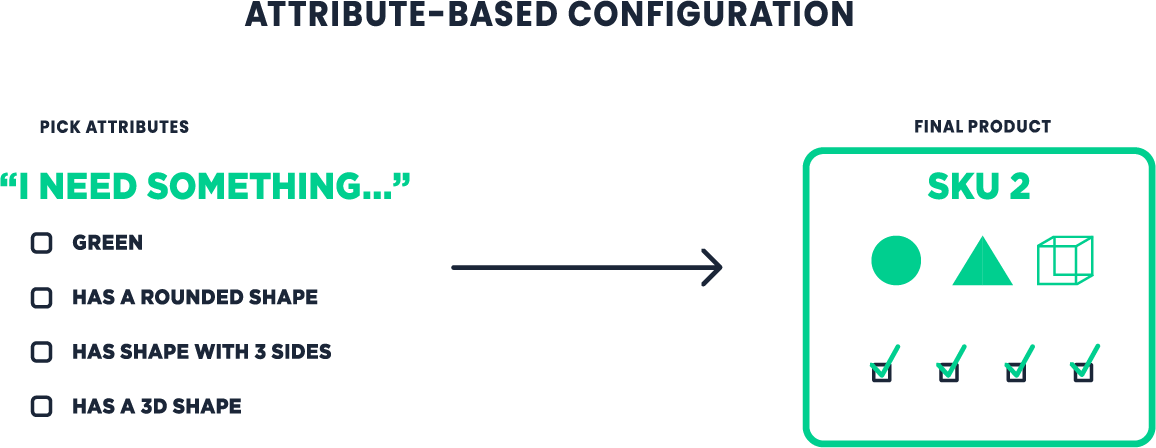
Attribute-Based Configuration
Attribute-based configuration serves to address the shortcomings,
gaps in potential, and static nature of existing product-based configuration options. It reverse-engineers the buying process, focusing first on the buyer needs and wants through questionnaires or guided prompts, then leveraging pre-loaded system logic to scan the product catalog to configure the optimal sales suggestion.
Or, as Haussler puts it, leveraging attribute based configurations answers the question of “what happens if you untether the questions you can ask from the products you’ve got."
Calling back to the market shift that came as a result of the Information Era, buyers are more approaching sales from the perspective of finding a solution to improve their quality of life, not necessarily as a means to get an item. The end goal is no longer just having a couch, but rather finding a way to utilize their existing living space in a way that aligns with their overall aesthetic and anticipated level of company. While legacy product- based configurators may withstand a certain level of manipulation and tweaking to provide a version of the attribute-based experience, there is only so much bend the system can take.
To future-proof a sales strategy and tech stack, making the shift to an attribute-based configurator makes the most sense, even if it may come with a front-load of work.
Fazal Gupta, Co-Founder & Head of Product
“Attribute-based configuration is the right
horse to bet on,” says Gupta, when considering
the options for businesses to carry with them
through the coming years. It is the best,
fastest and cheapest option to meet buyers
where they are and get them through the
sales cycle, successfully and repeatedly."
Haussler explains that the modern “service model isn’t around one buy, [but rather an] ongoing relationship that requires a lot more information about that customer.” The additional buyer preferences and data gathered through the attribute-based experience can further relationships between businesses and their clients. Keeping a finger on that pulse can allow for businesses to develop more targeted marketing campaigns, anticipate market shifts and advancements, and expand offerings based on existing customer desires. And the configuration model can be – and has been – applied to all sorts of industries.
Direct manufacturing, B2B, B2C, service providers, product distribution and more can benefit from the attribute-based configuration experience. In so many ways, attribute-based configuration provides a better customer experience and seller experience than product-based configuration, as it reduces the need for existing product knowledge and leverages system logic to match the buyer’s final needs
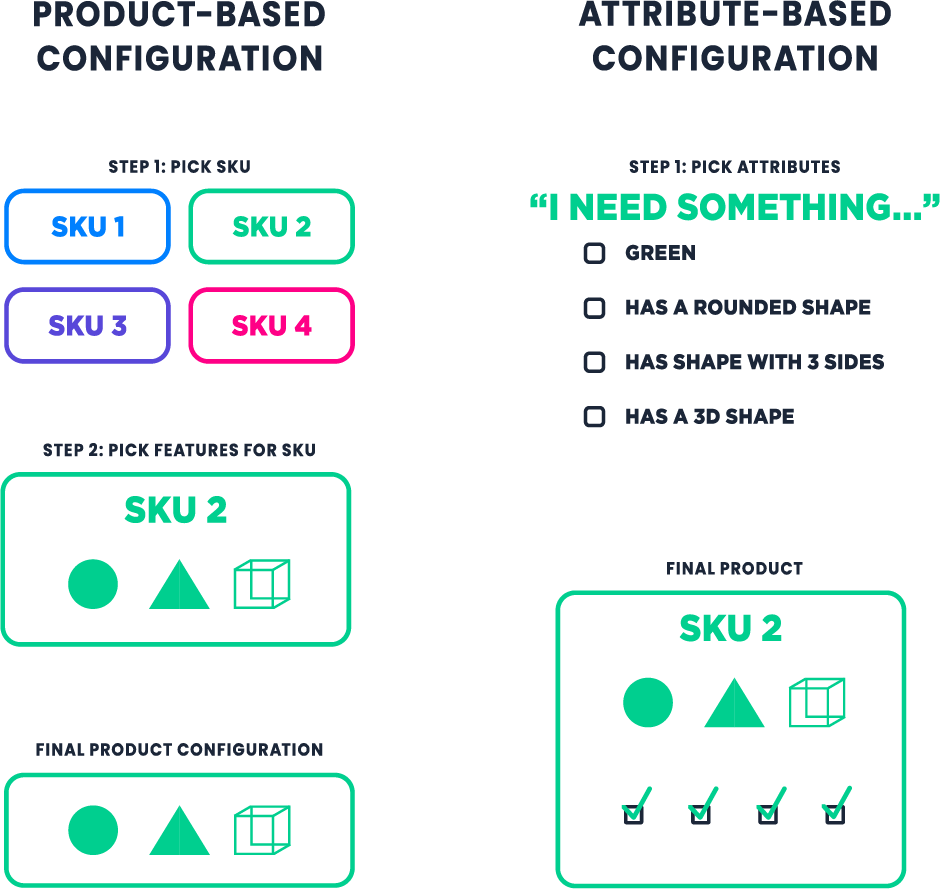
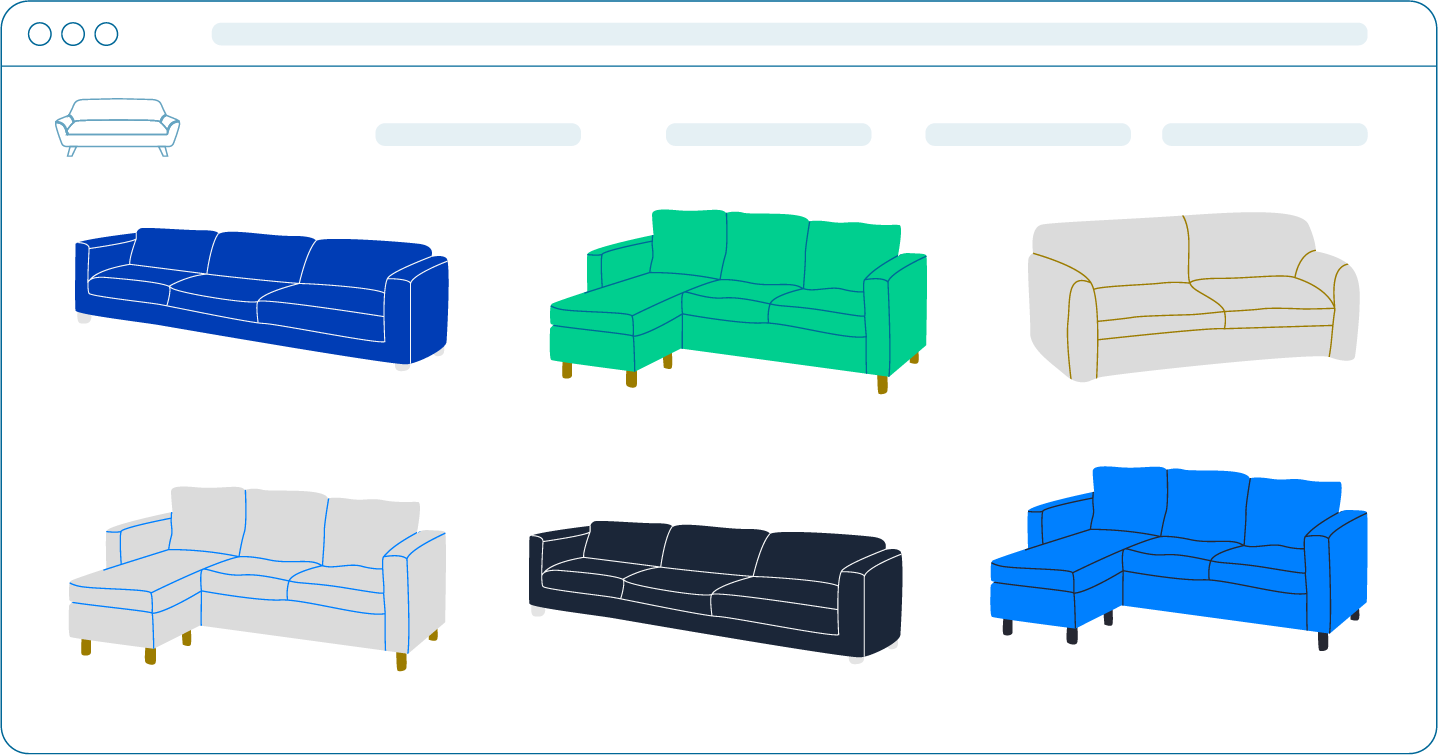
Practical Example of Product-Based vs. Attribute-Based
Let’s look, for example, at the online shopping experience provided by a big-box furniture retailer selling modular couches.
Let’s look, for example, at the online shopping experience provided by a big-box furniture retailer selling modular couches. The retailer in question has two different sizes for the couch, one composed of 6 modular pieces, and the other of 8. For either option, the retailer can have the couch manufactured in one of 10 different fabrics, ranging from leather to linen in assorted colors. Finally, the retailer allows buyers to select between finishings in brass, gold or silver to bring the entire couch together.
In a product-based configuration setup, buyers accessing the website would be faced with dozens upon dozens of unique line items – a 6p couch in grey leather with gold finishings, a 8p couch in grey leather with brass finishings, a 6p couch in grey leather with silver finishings, and so on – that account for each possible combination of variables. In order to parse through the product catalog successfully, the buyer would have to know exactly what they wanted to purchase going into the experience, or be willing to enter into and exit out of each option until they were satisfied with what they found. There is also a huge possibility that time will be spent creating line items for configurations that will never actually be ordered by the buyers, stressing both web space and admin maintenance needs.
In an attribute-based configuration setup, though, the process becomes exponentially quicker, and far more navigable for the buyer. Instead of having each possible product configuration accounted for in an existing line item, attribute-based configuration would simply present buyers with the core item catalog – here, say, 6p or 8p modular couches – to select from, with internal variable modification introduced after that selection. There could be an introductory question asking the buyer about the dimensions of their space, then suggesting the best match between the two options. So, if a buyer was directed toward a 6p couch from the initial menu based on their living room square footage, they could then configure their ideal fabric and finishing selections as an attribute of the best-fit product.
This is where Haussler says the power of attribute-based configuration comes into play. This experience better aligns with buyer expectations for customization and ease. There’s no need for the buyer to come in knowing exactly what they’re looking for, either. The reactive capacity of the attribute selection process allows them to whittle down all available options until they are fully satisfied with what’s in front of them.
Not only does attribute-based configuration streamline the process for the buyer themself, it provides an internal lift to the admin team responsible for maintaining the site, reducing costs and labor requirements. Instead of the dozens upon dozens of pre-configured line items requiring personal SKUs found in the product-based setup, attribute-based configuration only required back-end support for as many core items and variables are present in the product. In this example, only 2 core items and 3 variables would need to be maintained to accommodate the configuration for the exact same number of couches found in the first scenario, and SKUs would only need to be created for the actual orders sent to production. There’s a far lower risk of user error in attribute-based configuration, as buyers are able to manually input and adjust their desired parameters in real-time. With one wrong click in a product-based setting, buyers would have to start from scratch to get their wanted product into their cart.
Chris Haussler, Sr. Principal Product Manager
“product-based configuration
does not do well if I don’t know what the solution
to my problem is. It doesn’t get me closer.”
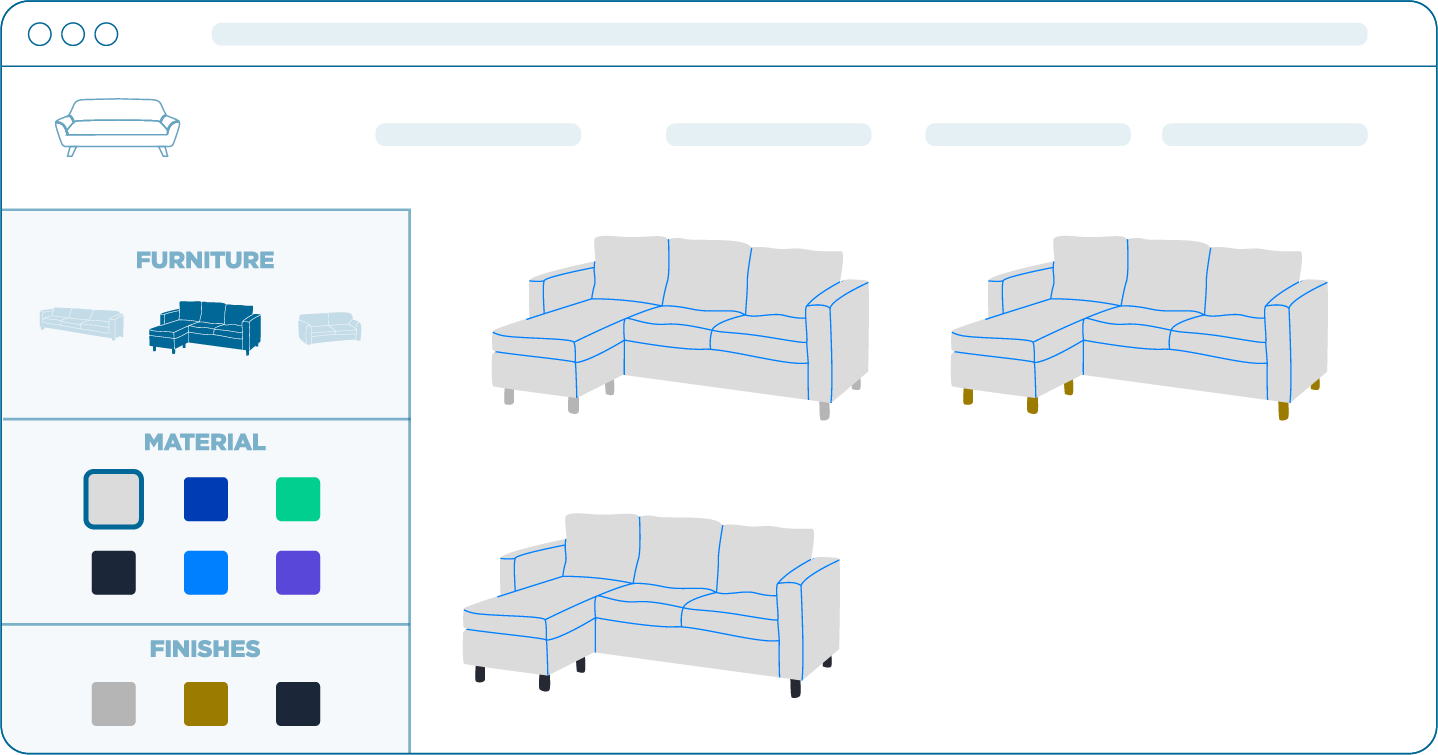
Which is Which?
How to know which is which when evaluating configuration solutions?
When you’re evaluating solutions, make sure you ask your vendor if their configurator is product or attribute-based. Here’s a quick guide based on our team’s experience of some of the top solutions out there:
Visit the Logk.io Product Blog